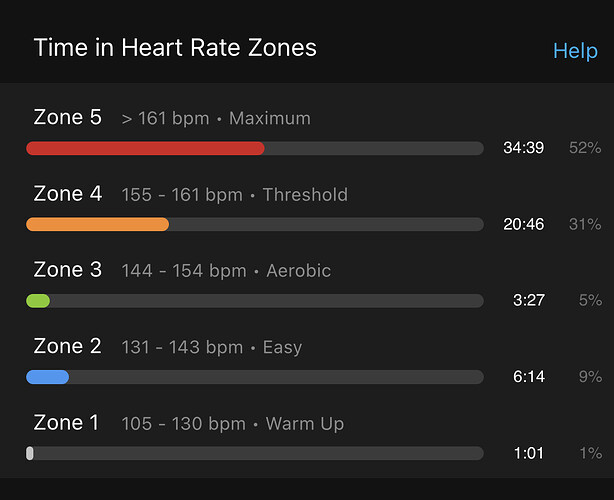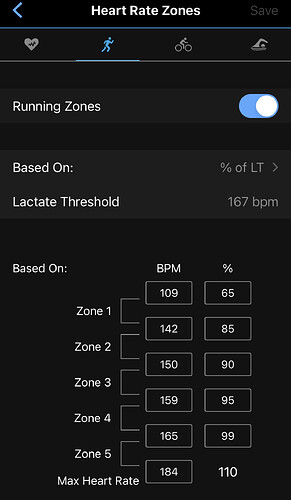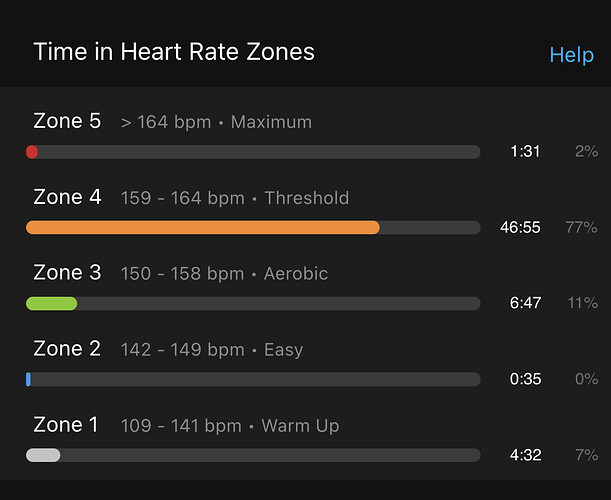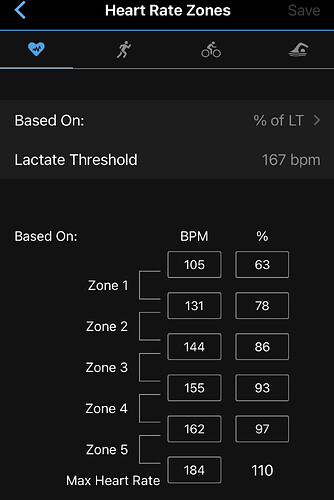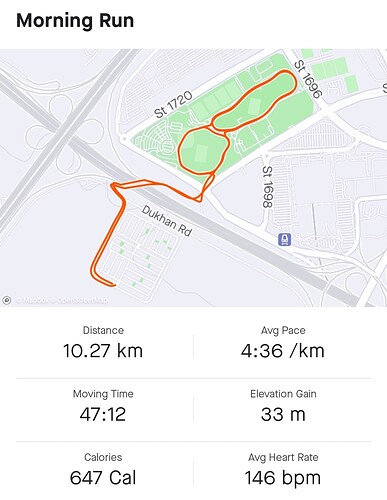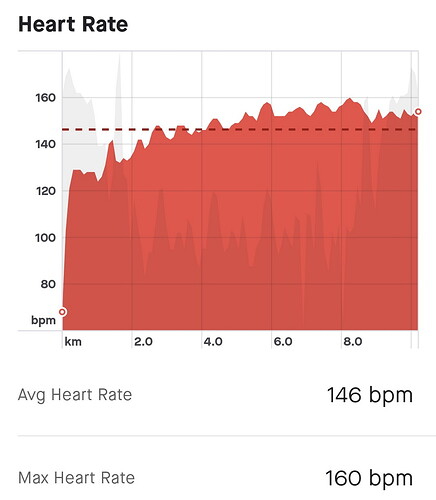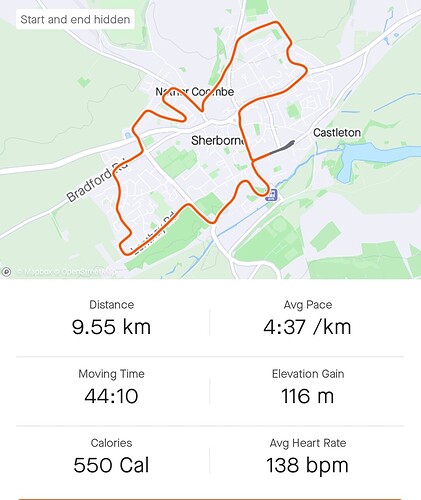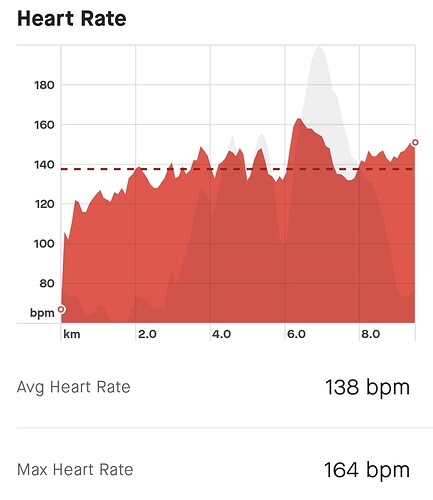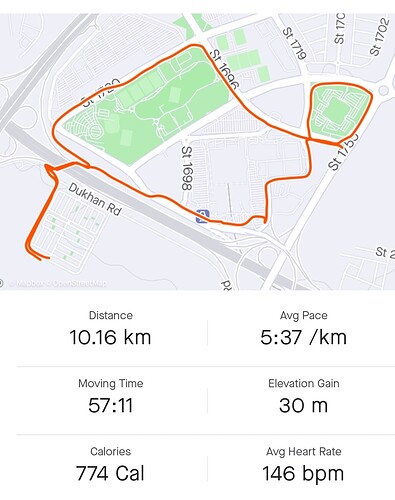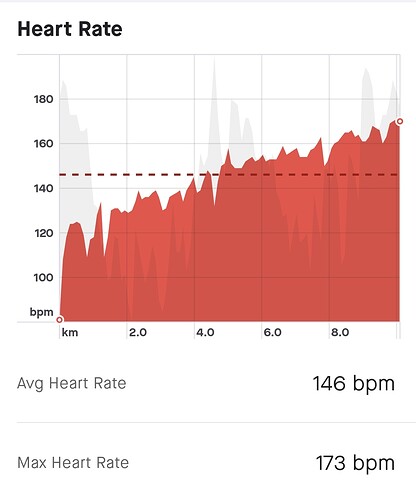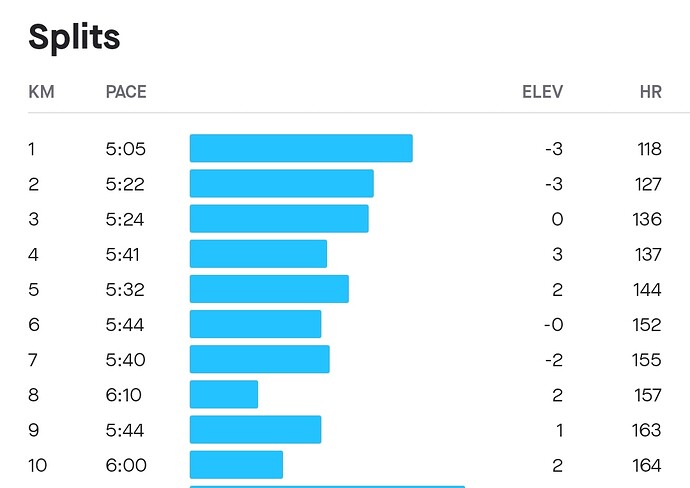Does anyone know what the percentages of LTHR zones should be, for the Garmin five zone model?
ChatGPT says:
The Garmin five zone model is a heart rate training model that uses five different zones to guide your training intensity. The zones are based on your Lactate Threshold Heart Rate (LTHR), which is the point at which your body starts to produce more lactate than it can clear.
The five zones and their corresponding LTHR percentages are:
- Zone 1: Recovery (50-60% of LTHR)
- Zone 2: Endurance (60-70% of LTHR)
- Zone 3: Tempo (70-80% of LTHR)
- Zone 4: Lactate Threshold (80-90% of LTHR)
- Zone 5: VO2 Max (90-100% of LTHR)
It’s important to note that LTHR can vary depending on the individual and can be affected by factors such as fatigue, hydration, and nutrition. Therefore, it’s a good idea to perform a lactate threshold test or a field test to determine your accurate LTHR instead of using approximate percent ranges.
This worked for me big in 2019, but it took 4/5 weeks to adapt, I’m going to try something like this in March
It’s currently largely forced by the groin issue I have. I might end up continuing it on for a few more weeks. But having a browse back over similar runs with the same pace, my HR is definitely lower so I think some improvements are already starting happen. The real test will come when I start to get back into some races.
Cheers. That means running an hour at LTHR is Z5, and called vo2max weird.
Zone names are different in GC:
I just ran for an hour at 162bpm
I’ve set zone using Friel’s percentages:
My half marathon paces run came out as
Garmin seems to reset the zones whenever it feels like it to some strange percentages when I’m not looking:
I’m observing something interesting since being in a warmer place.
Something about running here really makes my HR ramp up. I assume it’s the heat? Saw the same on previous visits, athough it’s not really all that hot right now.
eg. this morning I went for a run. 8am, 21C, strong sun, light breeze, pretty flat, good surface.
plan was 10km, and after a km or so warming up I tried to settle in at 4m30/km.
But HR started climbing… into zone 3 and knocking on the door of zone 4
by about 6km in it was feeling harder than it had any right to, and I stated slowing down.
Compared with this similar but hillier run in UK:
HR stays pretty level at the top of zone 2 except on the uphill.
Av HR is 8 beats lower despite hillier terrain and worse surface. Temperature was probably only 6 or 8 C though.
I thought I liked running in the heat, but perhaps this suggests that a bit of adaptation is needed first? Even though the temp was only 21C this morning, the sun felt strong and my skin felt hot. Will be interesting to see if this sorts itself out over the next few weeks.
I’d say almost definitely the heat. How’s your hydration before the runs, because that’s going to impact blood plasma volume and subsequently hr.
Remember you’ve been in winter for the last 3 months, so it’ll take a while to become adapted again to the heat I’d say. Give it a couple of weeks and see how it goes.
Maybe need to start drinking beer again ![]()
![]() so many possible confounding factors…
so many possible confounding factors…
Almost definitely the heat I’d say. Also I presume your using a chest strap and not wrist HR?
Wrist, but I believe it based on perceived effort. Did bring the chest strap out too, don’t like running wearing it much but might experiment just to check the data.
Think you’re probably right that it’s the heat, I was just surprised because 21C isn’t that hot.
mind you maybe it’s something about the humidty or sun warming up the skin too?
Back in the summer when it was 30-35C in the morning, HR went bonkers even at 6 mins/km, so I guess it’s following same pattern.
So yeah, guess if might be interesting to see if it stays this way or if there’s some acclimatisation- & if so how long it takes. Been out here for 12 days so far.
Yeah I’d get the chest strap out. I really don’t trust my wrist one much anymore (735xt) as I had a few runs this year where HR my rose up to 175 odd and stayed there during a 8-10km Z2 (5min km) run. Even though I was keeping the pace steady. Started using a chest strap and it hasn’t happened since. Tested just wrist again for a couple of runs and it did the same again for one of them.
I want a wrist based one for static bike workouts, would this be accurate you think ?
I used to ignore the wrist HR on my old forerunner 235, it was clearly wrong so often. Most common error was locking into stride cadence of around 170, for me that HR would be a top end sufferfest only ![]()
Currently using a much more basic forerunner 45 but actually feel this does seem to provide convincing HR data a lot of the time, for running at least. Sometimes it can be a bit slow to get started though.
Like anything it’s about how much you care and what you’re going to use HR for.
If you are doing steady prolonged indoor efforts, and it’s the average HR for a workout you want, I’d say you’re okay with wrist. Some people I’ve heard find their position on the bike interferes but I’ve never had that problem.
If you want to compare your HR at 4min vo2max intervals against your power, to
calibrate zones, detect early onset of illness, all whilst pairing both to your training app, simulating a real course and winning a Zwift race…then you probably want something more dedicated.
@fruit_thief, my HR is significantly higher in hot and in particular humid conditions.
Take a treadmill in a poorly ventilated gym, for example. I can still get it close to 200 (as I found out in Singapore a few years ago).
Definitely seem to think mine was warmer last year when I went to Europe despite being pretty warm here.
Will be interesting to see if it settles down as you adapt to the conditions.
electrocardiography is always going to be more accurate than optical sensors…
As per @Sowler & @explorerJC , went for the same run this morning with chest strap, similar conditions, and am way happier with the HR data.
chest strap it is then ![]()
How did the RPE compare? Seems a bit quick to be adapting?
Felt a lot easier today actually. Possibly was having an off day earlier in the week, had a bit of a gut thing going on which has got better. Dunno . Will keep an eye ![]()
